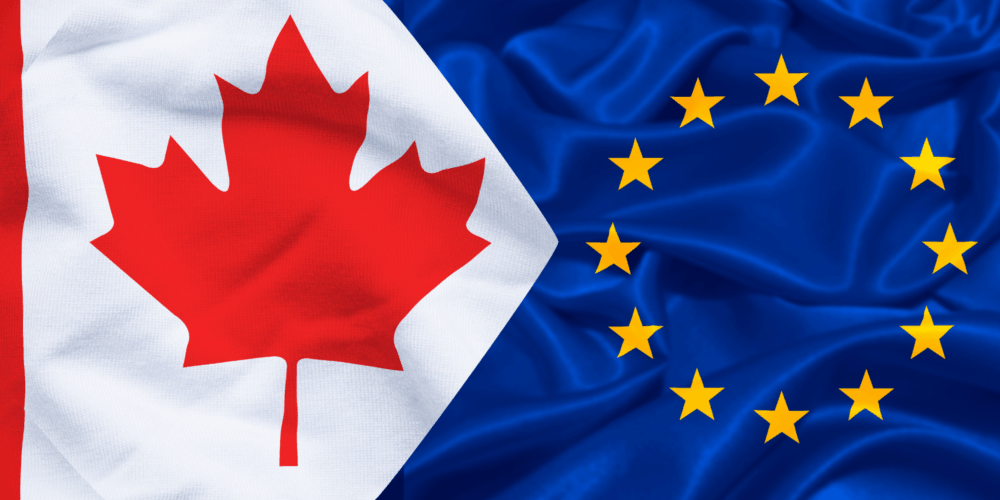Canada and Europe Deepen Defense Ties Amid Rising Global Instability

By Dr. Kim Eduard Lioe and Pia Kauer
In times of geopolitical uncertainty, reliable partnerships are more crucial than ever. Russia’s war of aggression against Ukraine, China’s geopolitical rise, and the U.S. retreat from its traditional leadership role are forcing Western democracies to rethink their security policies. Against this backdrop, the newly signed defence partnership between the European Union and Canada marks a strategic milestone — and an opportunity to reshape security dependencies.
While Germany remains primarily focused on Russia’s war against Ukraine and Moscow’s use of hybrid warfare, Canada is also looking northward. Canada faces several emerging threats: increased Russian activity in its airspace, the regular deployment of Chinese dual-use research vessels, and a general uptick in Arctic maritime operations.
In light of Canada’s deep dependence on US military technology, a shift toward greater strategic autonomy is long overdue.
Encouragingly, this sense of urgency has already spurred several promising developments:
1. Ongoing Partnership in Ukraine
Canada remains one of Ukraine’s most committed allies, having pledged $4.5 billion in military assistance since 2022, and contributing to Germany’s Immediate Action on Air Defence (IAAD) initiative, which pools resources from the international community to speed up the delivery of air defense systems for Ukraine. Both Canada and Germany lead NATO battle groups in Latvia and Lithuania, respectively, and are working to scale these up to full brigade strength.
2. Increased Military Spending
Russia’s full-scale invasion of Ukraine revealed that Europe was not prepared for a high-intensity, prolonged conventional war. Canada, like Germany, has historically underinvested in defense. However, Mark Carney’s government is ramping up its defense spending. While Justin Trudeau had promised to reach the 2% target by 2032, Mark Carney announced that it would be achieved in March 2026, up from 1.4% in 2024. At the 2025 NATO Summit in The Hague, this target was increased to 5% by 2035 in a joint agreement with European NATO members.
“The new agreement adds a parallel channel — a distinct European-Canadian defence architecture.”
3. New Procurement Initiatives
On the margins of the EU-Canada summit 2025, the High Representative of the European Union for Foreign Affairs and Security Policy Kaja Kallas, Canada’s Minister of Foreign Affairs Anita Anand and Minister of National Defence David J. McGuinty announced a new European-Canadian Security and Defense Partnership (“SDP”), which will open the door for Canada’s participation in the EU joint procurement program SAFE („Security Action for Europe“). At its core lies a deeper cooperation on military logistics, cybersecurity, and technological innovation. Until now, cooperation in these areas has primarily taken place within NATO. The new agreement adds a parallel channel — a distinct European-Canadian defence architecture. This development is more than symbolic; it reflects a genuine strategic shift, acknowledging that democracies must build new networks to confront evolving threats.
SAFE’s loans for the purchase of defense technology are only open to EU member states. However, Ukraine, EEA/EFTA countries, EU candidate nations and third countries with a Security and Defense Partnership can participate in the joint procurement process – lowering prices for all.
This is especially attractive for Canada which seeks to dramatically decrease its reliance from US defense technologies. Right now, Canada is spending around 70% of its military equipment appropriation on US-made gear.
For instance, Canada announced that it is considering buying European fighter jets in a move to reduce their dependence on US suppliers. And a trilateral letter of intent signed by Norway, Germany and Canada at last year’s NATO summit aims not only to strengthen maritime security co-operation in the North Atlantic but might also pave the way for Canada to join the existing German-Norwegian partnership, in which the two countries are deepening their strategic relationship, with a focus on addressing shared security challenges and enhancing their capabilities in key areas like maritime security and space.
While Canada not only aims to be a buyer but also a supplier under SAFE, participation comes with strict eligibility rules. To qualify, at least 65 % of the total value of a weapon system procured under SAFE must originate from manufacturers located in the EU, an EEA/EFTA state, or Ukraine.
Foreign suppliers can only be included in the 65 % threshold if their governments have a Security and Defence Partnership with the EU, and they then conclude a further bilateral agreement granting access to SAFE procurements. Since the EU and Canada have already agreed to swiftly launch negotiations on a new bilateral agreement, Canadian defence firms are optimistic that their products will soon comply with these requirements.
“Interchangeability of key equipment turns fragmented capabilities into collective strength.”
4. Increased cooperation
In addition to granting Canada access to SAFE, the Security and Defense Partnership between Canada and the EU will increase cooperation on military assistance for Ukraine and aims to enhance the compatibility of Canadian and European military equipment and the cooperation of military personnel.
Of particular promise is the deepening of defence-industrial ties. This not only opens economic opportunities but also promotes technological exchange and industrial innovation.
Both partners face similar challenges: modernizing outdated equipment, building resilient supply chains, and protecting critical infrastructure. A coordinated approach to procurement can eliminate redundancies, reduce costs, strengthen interoperability between armed forces and interchangeability of equipment.
And for Junghans Defence, a long-standing partner of Canada in the field of fuzes for various types of ammunition, business and cooperation models are evolving. Local production of interchangeable fuzes e.g. for artillery ammunition in collaboration with partners in Canada is the logical result.
Interchangeability of key equipment such as fuzes and ammunition turns fragmented capabilities into collective strength by ensuring that ammunition is not just available but usable, by anyone, anywhere, without delay. Interchangeability therefore is not just a convenience – it’s a matter of battlefield readiness.
In conclusion:
Despite its promise, the EU-Canada partnership still faces significant challenges. Implementation details are still to be worked out. Long-term success will also depend on political consistency on both sides of the Atlantic. Another question is how this partnership will coexist with NATO. How can overlapping efforts with the U.S. be harmonized? What role will post-Brexit Britain play in a landscape where it is neither fully in the EU nor closely aligned with Canada?
Yet the deepened EU-Canada cooperation sends a powerful message: that democratic nations can build resilient, innovative, and independent security structures without depending on volatile bilateral relationships. It would be naive to believe that Europe and Canada could replace the US as a protective power and supplier of military technology for each other. Nevertheless, efforts to strengthen cooperation are promising, and in the best-case scenario, they will enhance security in Europe and North America while bolstering their respective economies through friendshoring.
In a world where security is increasingly networked, technology-driven, and global in scope, this partnership is both timely and necessary. The EU gains a reliable partner across the Atlantic. Canada gains strategic autonomy and access to major markets and innovation platforms. For both, this is more than an agreement — it is a strategic promise for the future.
 Dr. Kim Eduard Lioe is the CEO of JUNGHANS Defence, a global leader in the manufacture of igniters and ignition systems. He is the author of the book “Armed Forces in Law Enforcement Operations? – The German and European Perspective” and spoke on a panel at this year’s German-Canadian Conference.
Dr. Kim Eduard Lioe is the CEO of JUNGHANS Defence, a global leader in the manufacture of igniters and ignition systems. He is the author of the book “Armed Forces in Law Enforcement Operations? – The German and European Perspective” and spoke on a panel at this year’s German-Canadian Conference.
